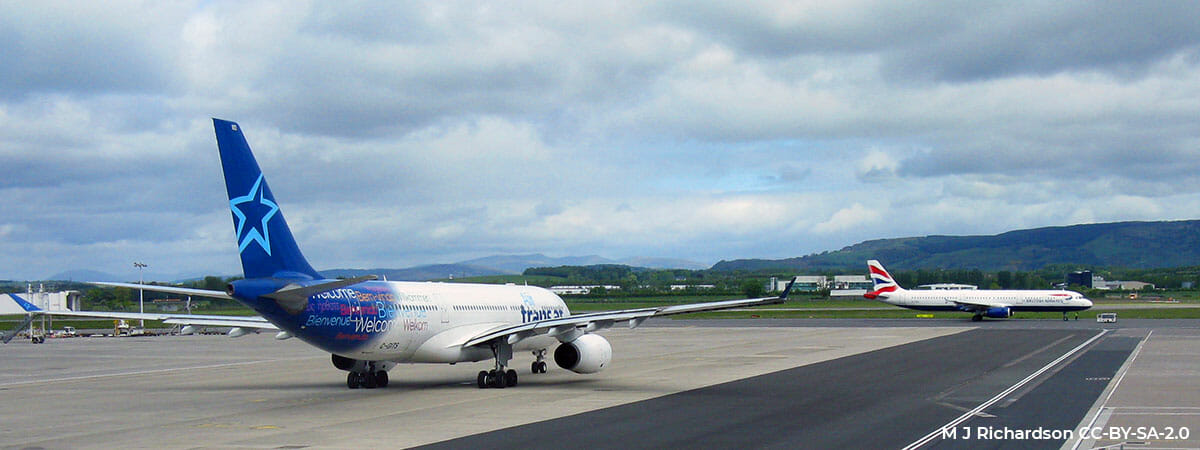When debating the effects of human activity on the environment, we often take an overly simplified approach to an issue that has many variants and different points of view.
Answering the question “Which mode of transport is the biggest polluter?” would be simple if we only considered the greenhouse gas emissions produced during travel. The answer would be road transport, which is responsible for almost 16% of total emissions. The least polluting would be rail transport, which accounts for just 0.2%, followed by air transport at around 2%.
We tend to measure the impact of different modes of transport solely based on their greenhouse gas emissions. However, it would be more accurate to look at the impact they have over their entire life cycle.
However, the equation becomes more complicated if we take a broader view of the situation.
We assume that greenhouse gas emissions are linked to the actual journey — i.e., per mile and passenger — and forget that the impact of a means of transport also includes the infrastructures that make this journey possible (roads, tracks, ports, airports, stations, etc.).
We also tend to leave out the impact of industries that generate, store, and consume energy (thermal power plants, hydroelectric power plants, oil fields, the battery manufacturing industry, mining companies that extract the required resources, etc.). In turn, building and running these infrastructures has an enormous impact, which is spread out over the course of their service life according to a number of variables. This simplified answer also fails to consider the full life cycle of the vehicles used (manufacturing, spare parts, solid waste, or scrapping). We really can make the equation rather complicated.
So far, we have discussed some of the negative impacts that might enter into the equation when establishing which mode of transport is the most damaging to the environment, but we should also take into account the benefits they provide. Obviously, there is no “balance” between these negative and positive impacts as all means of transport have an overall negative impact on the environment. Nonetheless, both extremes should still be part of the equation.
For example, it is generally agreed that air transport is accountable for around 2% of total greenhouse gas emissions. It is also true that this mode of transport provides a number of social and economic benefits, including fast travel, time savings, medical care, humanitarian support, tourism, business, and cargo transport, to name but a few. As we said before, when it comes to calculating the impact, some important aspects must also enter into the equation such as the repercussion of the infrastructures associated with a mode of transport, airports in this case, which also have both negative (occupied land, access, emissions, waste, etc.) and positive effects (jobs generated, facilities for passengers, indirect economy, etc.).
As we can see with this example, a serious debate regarding the impact of each mode of transport should cover a much broader perspective. Therefore, we must analyse the impacts throughout the entire cycle, from designing, building, and maintaining the necessary infrastructures to running each means of transport. In fact, the impact of the infrastructures used for each type of transport is rarely addressed when talking about the environmental impact. Nobody can deny that building, running, and maintaining roads, highways, bridges, ports, airports, and other transport infrastructures destroys natural resources and generates greenhouse gases and air pollutants, among other impacts.
Let’s take a look at some rough figures regarding different modes of transport…
- There are some 22 million miles of roads on the world’s surface that are used by more than 1,400,000,000 vehicles.
- One million vertebrates are killed on US roads every day.
- There are around 820,000 miles of railway tracks in the world.
- Worldwide, there are around 7,000 commercial aviation facilities, including aerodromes with small unpaved runways for light passenger aircraft.
- There are some 6,000 seaports in the world, of which just over 1,200 have large cargo handling facilities. In addition, there are around 8,000 marinas.
These figures are reflected in a number of impacts that may not seem significant in isolation, but are striking when considered as a whole:
Construction activities, forest clearing, land levelling, or the actual building process related to any of these transport infrastructures may disturb natural wildlife habitats and cause foreseeable phenomena such as soil erosion or water pollution.
Transport infrastructures, especially linear constructions like roads or railways, also cause biodiversity loss as they can fragment ecosystems and displace wildlife. For example, thousands of animals die every day after being hit by vehicles. In addition, noise and light pollution from the transport sector can also alter the behaviour of wild animals and affect their migration patterns and breeding cycles.
Greenhouse gas emissions from the transport sector also make a significant contribution to global warming and climate change. Carbon dioxide, which is released when fossil fuels are burnt, is the greenhouse gas generated in the largest quantity by the transport sector. The transport sector is responsible for about one third of all carbon dioxide emissions globally, making it a major contributor to the global warming crisis.
Despite the pessimism of the statements above, this is a reality that we have to live with. Transport infrastructures play a crucial role in modern society but also have a significant impact on the environment.
As we have already established, it is difficult to determine which types of transport infrastructures are “better” or “worse” for the environment as many factors come into play. That said, here are some general observations regarding the environmental impact of different types of transport infrastructure:
1. Roads: Building and maintaining roads can damage wildlife habitats, fragment ecosystems, or cause soil erosion and water pollution. Vehicles also contribute to air pollution and greenhouse gas emissions when driven on the roads.
2. Airports: Building and expanding airports can destroy wildlife habitats and lead to biodiversity loss. In addition, aircraft emissions from ground operations have an impact on the surroundings.
3. Ports: As a result of port operations including shipping and cargo handling, pollutants such as oil, grease, and chemicals may be discharged into waterways and this can have a negative impact on marine ecosystems. Building and expanding ports and terminals can also destroy swamps and wetlands, which provide important habitats for many species of fish, birds, and other wild animals.
4. Railways: Building railway lines can also fragment wildlife habitats and damage biodiversity. However, rail transport is generally considered less harmful to the environment than road and air transport as it produces fewer greenhouse gas and air pollutant emissions per passenger and mile compared to cars and planes.
Railways are an interesting case. A priori, this is the most environmentally “friendly” means of transport if we only take into account the impact of emissions linked to travel. However, if we analyse the entire cycle, we see that railway tracks are a barrier that fragments habitats, or that reservoirs (with the impact that this entails) and electricity distribution plants must be built to produce the energy that powers this mode of transport, not to mention the millions of square feet occupied by the tracks (linear infrastructures that fragment habitats), stations, and platforms.
For the past decade or so, various groups and organisations have gone to great efforts to criminalise air transport. Although it does have a negative impact on the environment, just like any other means of transport, by no means is it the biggest polluter. Moreover, because these infrastructures and operations are highly regulated and controlled, it is much easier to take action to reduce their impact.
In fact, there is a collective commitment to drastically reduce emissions, as well as strict and well-established work plans to make this goal a reality, something that is not often seen in other sectors. Airport managers, operators, handling companies, airlines, and engineering companies alike are all focused on achieving this aim like in no other industry.
Based on a global decarbonisation agreement reached at the 41st ICAO Assembly in Montreal, the governments of more than 190 countries have committed to reaching zero emissions by 2050. This is a long-term plan to reduce carbon emissions from flights and airport activity. The five main aviation associations in Europe — Airports Council International Europe (ACI Europe), Airlines for Europe (A4E), Civil Air Navigation Services Organisation (CANSO), European Regions Airline Association (ERA), and Aerospace and Defence Industries Association of Europe (ASD Europe), which come together under the Destination 2050 initiative — expressed their full support for and commitment to this agreement.
The aim of this initiative is that all flights in and out of the EU, the UK, and the European Free Trade Association (EFTA) will have net zero CO2 emissions by 2050.
As for airports, more than 500 have already gained the Airport Carbon Accreditation. In fact, airports are possibly the most visible element of the impact generated by air transport for citizens. The measures being taken can already be seen in most of them:
1. Energy efficiency: Airports are reducing the amount of energy that they consume by installing energy-efficient lighting and heating/cooling systems, as well as implementing energy saving strategies in their operations.
2. Renewable energy: Airports are incorporating renewable energy sources into their energy mix to reduce their carbon footprint and dependence on fossil fuels. In fact, some of them are already using 100% renewable energy sources such as solar, wind, and geothermal power.
3. Sustainable transport: Some airports specifically promote sustainable transport options such as public transport and car or bicycle sharing to reduce the number of vehicles on the road and reduce emissions from transport.
4. Sustainable waste management: Airports are implementing sustainable waste management practices such as recycling and composting to reduce waste and greenhouse gas emissions from landfills.
5. Water conservation: Many airports already use water responsibly as they have efficient irrigation systems, harvest rainwater, and minimise the amount of water used in their operations.
6. Biodiversity protection: This is more complex because most airports have been in the same location since the last century, but many choose to protect biodiversity by preserving and restoring wildlife habitats and adding green spaces to their infrastructure, such as green roofs and gardens.
7. Stakeholder engagement: Airports are engaging with stakeholders, including airlines, passengers, local communities, and environmental organisations, to raise awareness of environmental issues and encourage sustainable practices.
Going back to the initial question of which mode of transport is the biggest polluter, the answer would still be road transport. However, we can also state that all of them pollute in one way or another, while simultaneously providing social benefits of varying importance. We should focus on trying to strike a balance between these factors and on creating the world we wish to leave behind for our children.



